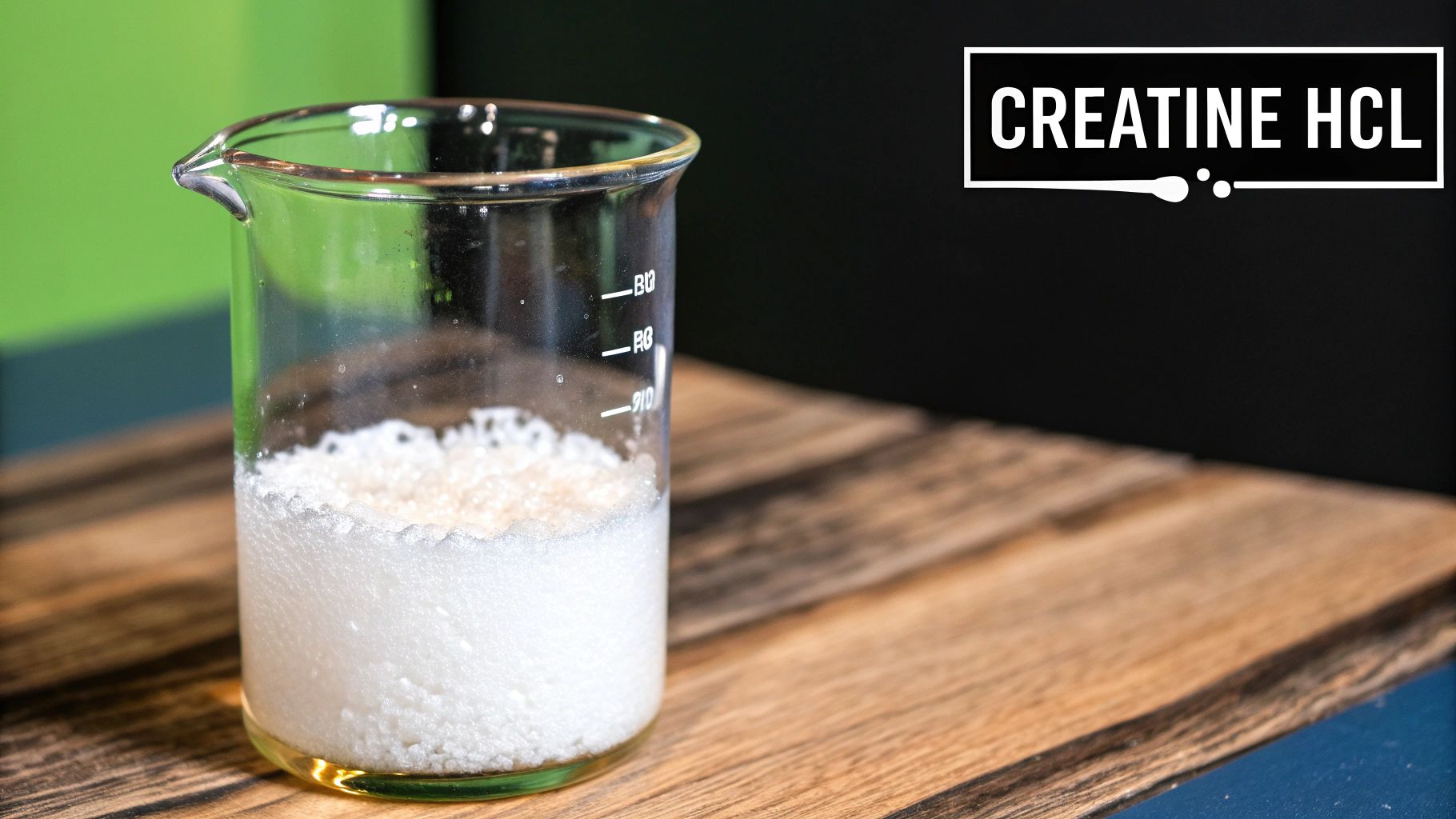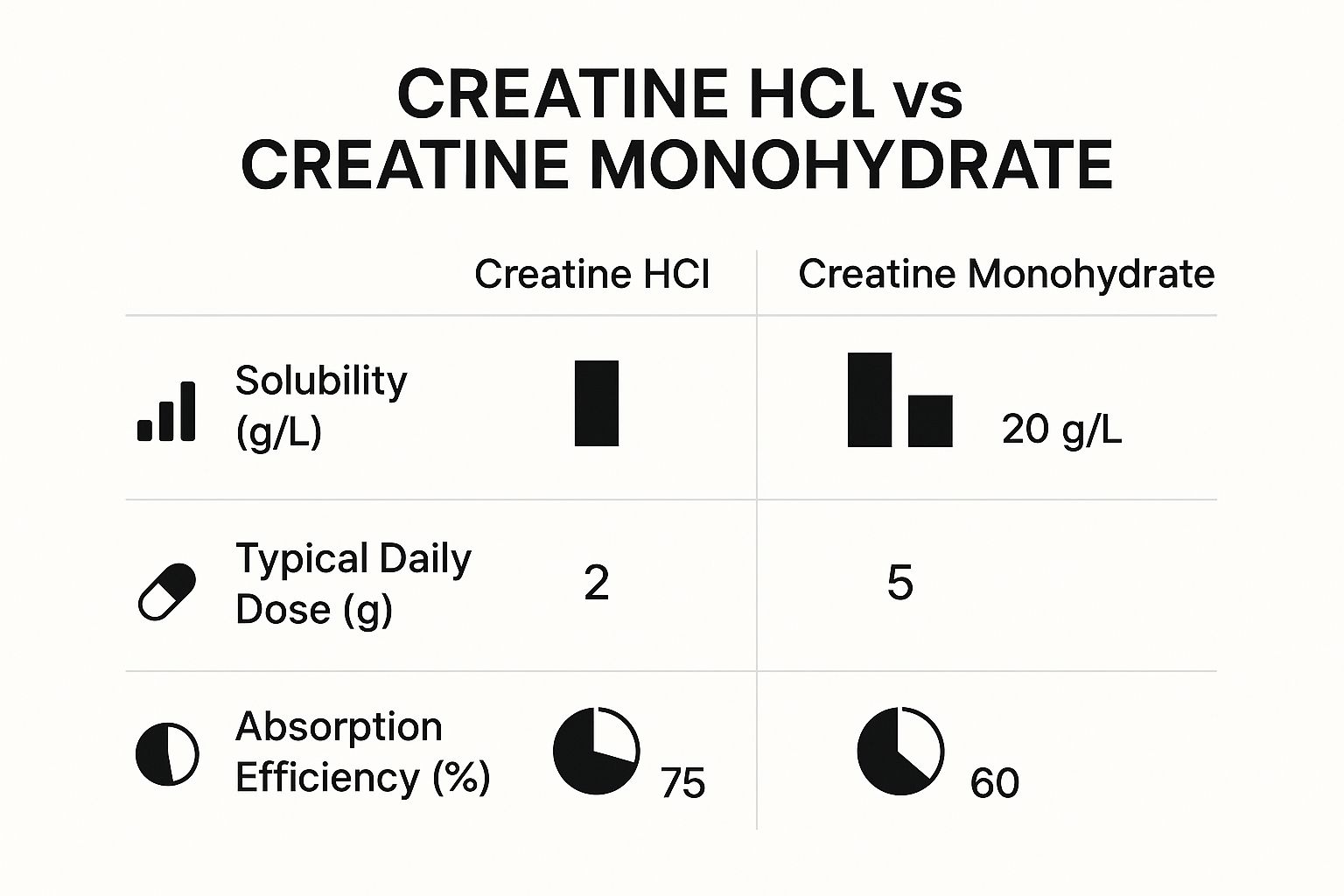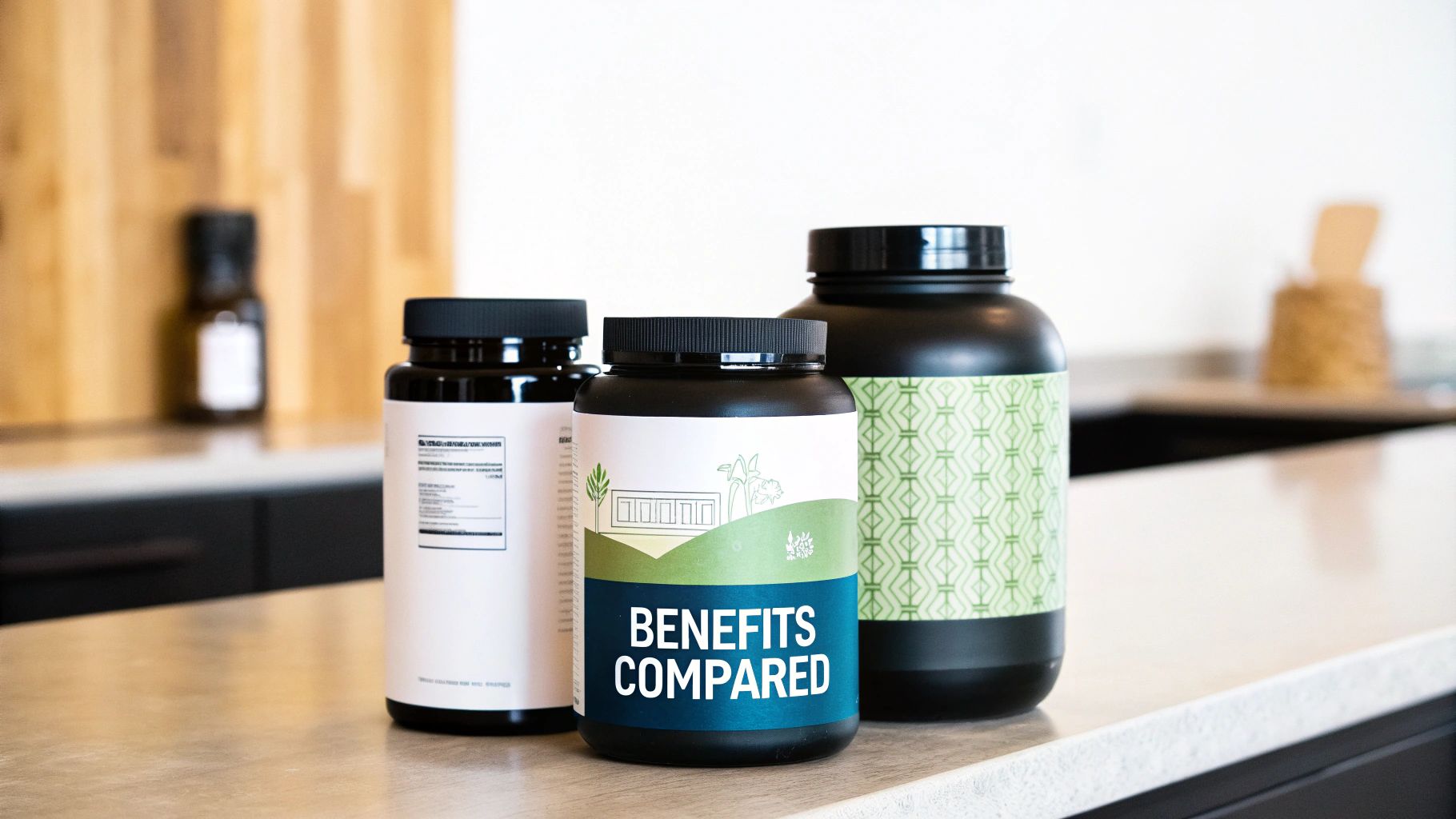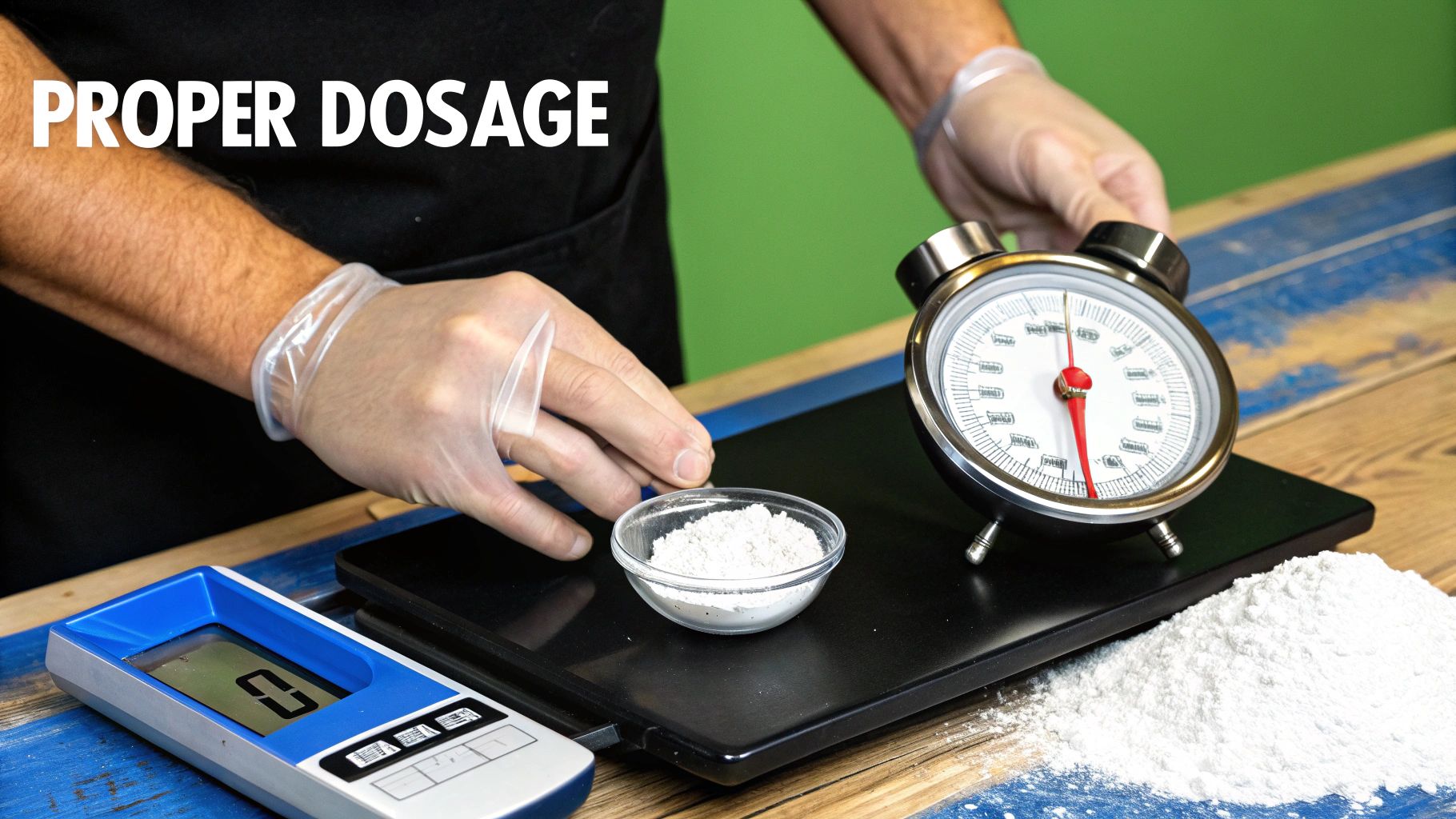
HCL Creatine vs Monohydrate: Which Is Best for You?
Share
When you're standing in the supplement aisle looking at creatine HCl vs monohydrate, the choice can feel confusing. But the core difference is actually pretty simple. Creatine monohydrate is the original, the one with decades of research behind it. Creatine HCl, on the other hand, is the newer kid on the block, engineered specifically to dissolve better in water.
Creatine Monohydrate: The Time-Tested Foundation
There's a reason creatine monohydrate is called the "gold standard"—it's arguably the most studied sports supplement ever. Its chemical structure is basic: a creatine molecule attached to a single water molecule, hence the name mono-hydrate. This simple formula has been put to the test in over 500 peer-reviewed studies, all pointing to the same conclusion: it works for building strength, power, and muscle mass.
So, how does it do it? When you supplement with monohydrate, you're topping off your muscles' phosphocreatine reserves. Think of phosphocreatine as the fuel injector for your body's energy engine, helping to rapidly create ATP (adenosine triphosphate). ATP is the high-octane fuel for short, explosive movements like heavy lifts or all-out sprints. More phosphocreatine means you can crank out ATP faster, letting you squeeze out those extra reps or hold your sprint speed just a little longer.
Why It Remains the Benchmark
Creatine monohydrate’s reputation isn’t built on hype; it’s built on decades of real-world results and an mountain of scientific proof. The performance gains aren't just theoretical—they show up in the gym and on the field. This extensive research history also gives it a rock-solid safety profile, making it a dependable choice for everyone from beginners to seasoned pros.
Its dominance in the market really tells the story. Creatine monohydrate makes up a staggering 71.3% of the entire global creatine market. That kind of market share comes from a product that's proven, effective, and affordable, cementing its place as the industry benchmark. You can get a better sense of these trends by looking into the creatine industry on Grandviewresearch.com.
For the vast majority of people, creatine monohydrate is the smart choice. It delivers a powerful mix of proven effectiveness, established safety, and great value, making it the ideal supplement for building a solid foundation of strength and performance.
You might also see "micronized" creatine monohydrate on shelves. It's the same stuff, just ground into a much finer powder. This little tweak helps it dissolve more easily in water and can improve absorption, tackling one of the few minor complaints about the standard version. To get the full picture, check out our guide on monohydrate vs. micronized creatine. In the end, whether it's standard or micronized, monohydrate has earned its legacy by consistently delivering results for athletes for decades.
Creatine HCL: The Modern Alternative
As the science behind sports supplements advanced, so did creatine. This evolution gave us Creatine Hydrochloride (Creatine HCL), a form specifically engineered to tackle some of the well-known drawbacks of its older sibling, monohydrate. The whole idea behind HCL was to improve solubility and reduce the chances of digestive issues.

The secret is in the chemistry. By attaching a hydrochloride group to a creatine molecule, scientists essentially created a creatine salt. This simple change makes the compound more acidic, which has a massive impact on how well it dissolves in water.
This increased solubility is really the core of the creatine hcl vs monohydrate discussion. Because HCL dissolves so completely, the theory is that it gets absorbed much more efficiently by your gut. This means you avoid the undissolved creatine particles that can sometimes lead to the bloating or stomach cramps people report with monohydrate.
Smaller Doses and Better Comfort
The biggest practical benefit of better absorption is that you don't need to take as much. It’s simple logic: if your body is using more of what you take, you can get the same muscle saturation with a smaller dose. This is why Creatine HCL is often recommended in "micro-doses" of just 1.5-2 grams a day, a noticeable drop from the standard 3-5 grams for monohydrate.
Creatine HCL is really positioned as the go-to for anyone who has struggled with monohydrate. Its fantastic solubility is designed to give you all the performance benefits without the digestive side effects, making it a much more comfortable option for sensitive users.
This user-friendly angle has helped Creatine HCL carve out a solid niche in the market. While monohydrate is still king, there's a growing demand for specialized forms that offer specific advantages. As detailed in these insights on creatine derivatives at Fortune Business Insights, consumers in North America, Europe, and Asia are increasingly looking for supplements that prioritize quick absorption and stomach comfort.
Even though HCL doesn't have the mountain of research that monohydrate does, it's a very compelling choice if you value how easily your creatine mixes or if you’ve had digestive troubles in the past.
Comparing Core Differences in Solubility and Dosage
When you're standing in the supplement aisle staring at tubs of HCL creatine vs monohydrate, the real-world differences come down to two simple things: how they mix in your shaker cup and how much you need to take. These distinctions aren't just marketing fluff; they're rooted in the chemistry of each compound and directly affect your daily routine.
Creatine monohydrate is the original, time-tested formula. It's simply a creatine molecule bound to a single water molecule. It works, no question about it, but it’s notorious for not dissolving well. If you’ve ever swirled a scoop of monohydrate in water, you know exactly what I mean—that chalky sediment at the bottom is the undissolved creatine left behind.
On the other hand, Creatine HCL is a creatine molecule attached to a hydrochloride group. This small chemical change turns it into a creatine salt, which significantly boosts its acidity and, more importantly, its ability to dissolve completely in liquid. This is the key advantage HCL brings to the table.
The Real Impact of Solubility
So, who cares if it dissolves better? Well, for starters, it makes for a much more pleasant drinking experience. With Creatine HCL, a few quick shakes are all it takes to get a clear, smooth drink. Gone are the days of choking down a gritty last gulp or constantly re-shaking your bottle. For many, this is a massive quality-of-life improvement.
But it’s not just about convenience. The whole theory behind HCL is that because it dissolves so well, your gut can absorb it more easily. When creatine is fully dissolved, it gives your intestines a much larger surface area to work with, which could mean less risk of the stomach cramps or bloating that some people report with poorly-mixed monohydrate.
The core idea behind Creatine HCL is simple: better solubility leads to better absorption. This allows for a much smaller dose while sidestepping the potential digestive issues sometimes linked to monohydrate.
This graphic really highlights the key data points when comparing the two.

As you can see, that huge difference in solubility is what drives the different dosage recommendations for each type of creatine.
Dosage Differences and The Loading Phase
This solubility discussion leads directly into how much you actually need to take. Since Creatine HCL is believed to be more bioavailable—meaning your body absorbs and utilizes more of it—the serving size is much smaller.
A standard daily dose for Creatine HCL is just 1.5–2 grams. That’s a pretty big drop from the typical 3–5 grams per day recommended for creatine monohydrate, and it’s one of HCL’s biggest selling points.
What’s more, this efficiency means you can often skip the "loading phase" entirely. With monohydrate, it’s common to kick things off by taking 20–25 grams a day for a week to quickly saturate your muscles. HCL advocates argue that its superior absorption makes this high-dose period unnecessary. You can just start with the small maintenance dose from day one and get straight to business.
For a more detailed breakdown on how to dial in your personal intake, our complete creatine dosage guide has you covered with expert advice for every level.
To make the choice crystal clear, let's break down the head-to-head comparison in a simple table.
Key Differences Between Creatine HCL and Monohydrate
| Attribute | Creatine Monohydrate | Creatine HCL |
|---|---|---|
| Solubility | Low; often leaves a gritty residue in liquid. | High; dissolves almost completely for a smooth mix. |
| Dosage | Standard dose is 3–5 grams per day. | Smaller dose of 1.5–2 grams per day. |
| Loading Phase | Often recommended (20–25g daily for 5-7 days). | Generally not required due to higher absorption. |
| Side Effects | Some users report bloating or stomach discomfort. | Less likely to cause digestive issues. |
Ultimately, the right choice really boils down to what you value most. Monohydrate is the undisputed, heavily-researched champion, but it requires a larger dose and can be a pain to mix. HCL offers fantastic mixability and a smaller, more convenient dose—a trade-off many are happy to make for better ease of use and digestive comfort.
Side Effects and Digestive Comfort: A Key Differentiator
Let's be honest, when we talk about creatine HCl vs monohydrate, a big part of the conversation boils down to one thing: how it sits in your stomach. Creatine monohydrate is the undisputed king of performance supplements, but its one persistent critique is the gastrointestinal trouble it can cause for some people.
We've all heard the stories—or maybe experienced them firsthand. Bloating, a feeling of holding extra water, and stomach cramps are the most common complaints, especially when people follow a traditional high-dose loading phase.

So, what's going on? It often comes back to monohydrate's solubility. If the powder doesn't fully dissolve, those tiny undissolved particles can hang out in your gut, pulling water into the intestines. For some, this leads straight to irritation. While plenty of people use monohydrate without a single issue, it's a real dealbreaker for anyone with a sensitive stomach.
Where Creatine HCl Shines
This is precisely the problem Creatine HCl was designed to solve. Its main selling point is its incredible water solubility, which comes from the hydrochloride group bonded to the creatine molecule.
Because HCl dissolves so readily and completely, you're left with virtually no undissolved grit that could cause digestive upset. The theory is simple: a fully dissolved solution gets absorbed more cleanly and efficiently, drastically reducing the chance of bloating or cramps. This makes it a go-to for anyone who's had a bad run-in with monohydrate in the past.
The bottom line: Creatine HCl's chemical structure was engineered for a better user experience. By dissolving more effectively, it aims to give you all the performance perks of creatine without the digestive baggage that sometimes comes with the original formula.
Don't forget that staying hydrated is non-negotiable, no matter which form you choose. Proper water intake is essential for absorption and helps your cells use the creatine effectively. We cover this in-depth in our guide on the importance of drinking enough water with creatine.
Ultimately, your choice depends entirely on your own body. If you've been using monohydrate for years with zero complaints, there’s probably no compelling reason to switch. But if you're prone to digestive issues or just want the smoothest, most comfortable experience possible, Creatine HCl is the clear winner here.
Comparing Cost and Market Availability
Let's talk about the practical side of things: price and availability. Performance and side effects are one thing, but for most of us, budget plays a huge role in what ends up in our supplement stash. This is where the HCL creatine vs monohydrate debate gets pretty clear-cut.
Creatine monohydrate is, by a long shot, the more wallet-friendly choice. It's been the gold standard for decades, and its manufacturing process is incredibly efficient. This makes it a cheap and widely available staple you can find from literally every supplement company out there, from premium brands to bulk powder suppliers.
Creatine HCL, on the other hand, is marketed as a premium, next-generation product. The manufacturing is more involved and it's often backed by patents, which means you're going to pay more for it. A quick price check shows that HCL can easily cost you two to three times more per gram than monohydrate.
The Cost-Per-Serving Debate
This is where things get interesting. The main selling point for HCL is that you need less of it—about 1.5-2 grams per serving compared to the standard 3-5 grams for monohydrate. The argument is that this smaller dose helps make up for the higher price tag.
So, does it actually even out? Not really. When you do the math, even with the smaller serving size, monohydrate almost always wins on cost-effectiveness in the long run. The price-per-gram for HCL is just too steep for the dosage difference to close the gap.
When you break it down, the financial equation is clear. Creatine monohydrate offers the most cost-effective path to muscle saturation, delivering proven results at a fraction of the price of HCL.
Finding Your Creatine
The availability of each type also says a lot about its place in the market.
- Creatine Monohydrate: This is the default. It's everywhere. You can walk into any supplement shop or browse any online store and find it without a problem.
- Creatine HCL: This is more of a specialty item. You'll find it from many of the big brands, but the selection is much smaller. You might have to hunt a bit, and you’re less likely to find it from budget or bulk-focused companies.
Ultimately, your choice here boils down to your priorities. If you just want a proven, effective creatine that will give you the best bang for your buck, monohydrate is the undisputed champion. But if you’re willing to pay a premium for potentially better solubility and an easier time on your stomach, the extra cost for Creatine HCL might feel like a worthwhile investment for you.
Making the Right Choice for Your Fitness Goals

When you're staring at the shelf, the HCL creatine vs monohydrate debate isn't about which one is universally "better." It's a personal call. The right choice really comes down to what fits your body, your budget, and frankly, your daily routine.
For most people hitting the gym, creatine monohydrate is still the king. There's a mountain of research backing its effectiveness, and you can't beat the price. If you want proven performance without breaking the bank, monohydrate is your go-to. It's the reliable workhorse that's helped build countless physiques.
When to Consider Creatine HCL
So, where does Creatine HCL fit in? It shines by solving the few problems some people have with monohydrate. You might be a perfect candidate for HCL if any of these sound familiar:
- You Have a Sensitive Stomach: If you’re one of the unlucky few who gets bloated or upset after taking monohydrate, HCL's high solubility could be a game-changer for you.
- Convenience is a Top Priority: The idea of a "loading phase" is a turn-off, and you'd rather just take a tiny scoop. HCL’s micro-dosing makes it incredibly easy to just toss in a drink and go.
- You Can't Stand Gritty Shakes: Let's be honest, that sandy texture at the bottom of a shaker cup is unpleasant. HCL dissolves so well you'll barely know it's there.
At the end of the day, the best creatine is the one you actually take consistently. Monohydrate is the cost-effective, time-tested foundation for most fitness goals, while HCL is a fantastic, targeted solution for anyone who values digestive comfort and convenience.
Picking the right supplement is just one part of your overall plan. To get the most out of your training, it helps to explore holistic strategies for building muscle that cover everything from workouts to recovery. Listen to your body, consider what matters most to you, and pick the creatine that will best support your journey.
Got Questions? We've Got Answers
When you're trying to decide between creatine HCL and monohydrate, a few common questions always seem to pop up. Let's clear the air and give you the straightforward answers you need.
Do I Need to Load with Creatine HCL?
Nope, you can skip the loading phase. That whole process of taking 20-25 grams a day for a week is really just a monohydrate strategy to fast-track muscle saturation.
Creatine HCL is designed to be absorbed more efficiently, so you don't need to flood your system. You can just start with the regular daily dose—usually around 1.5-2 grams—and you'll get there without any extra hassle.
Can I Just Switch from Monohydrate to HCL?
You absolutely can. Making the switch is simple and safe. If you've been on monohydrate and are curious if HCL might be easier on your stomach or you just prefer the smaller dose, go for it.
Just stop taking monohydrate one day and start with HCL the next. There's no need for a "washout" period or anything complicated. Your muscles will stay topped up as you make the transition.
What really matters isn't which form you choose, but that you stick with it. Consistency is the key. Taking either HCL or monohydrate every day is what will ultimately drive your strength and performance gains.
Is Creatine HCL a Better Choice for Women?
One isn't automatically better than the other based on gender alone, but many women do lean towards Creatine HCL for one big reason: less bloating.
Because HCL is more soluble and requires less water to be absorbed, it's less likely to cause the water retention that can sometimes come with monohydrate. For anyone who gets frustrated by a sudden jump on the scale, HCL can feel like a more comfortable option. At the end of the day, both are proven to work wonders for female athletes; it just comes down to personal preference.
Tired of the whole powder and shaker bottle routine? Smash.com packs all the power of creatine into tasty, easy-to-eat gummies. It's all the gain, with none of the mess.